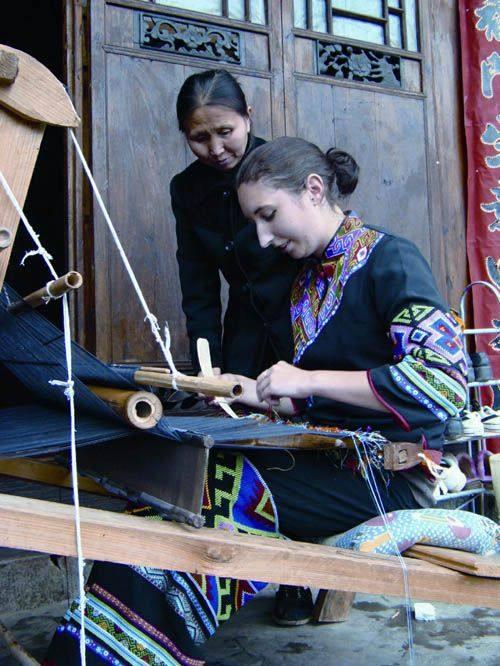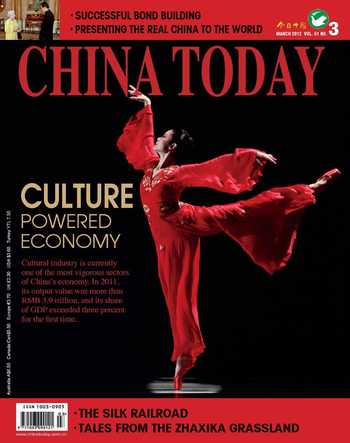Liu Dai’e – A Master Craftswoman of Tujia Brocade

In August, the osmanthus flowers blossom and send forth fragrance.
The Tujia girls are busy weaving brocade.
The fragrance drifts far away,
But the brocade girls cloth stretches even further.
– Song of Weaving Girls, traditional Tujia song
With no written language, the Tujia people have relied on their traditional craft of brocade weaving, known locally as xilankapu, to record their history and pass it on to future generations. Through these designs, the Tujia people express their understanding not only of history, but of life, society, nature and, of course, art.
This craft plays a part in everyday life of the Tujia people from birth, when a newborn baby will receive a brocade quilt from his or her grandmother. Tujia girls learn brocade weaving from a young age. Girls who can make fine brocade are considered clever and likely to win boyshearts. A brides parents will prepare at least one brocaded quilt for her as a dowry, the more the better.
Longshan County in Hunan Province is a center of Tujia brocade weaving. Within the county, Laochehe Village appears like some kind of Shangri-La, at the convergence of two crystal clear rivers. Ferryboats come and go on the rivers, whose banks are dotted with traditional wooden houses raised up on stilts. This picturesque village is the home of Liu Daie, a master craftswoman of Tujia brocade.
Liu was born into an ordinary Tujia family in 1955. She started to learn brocade weaving when she was just 12 years old. After graduating from high school, Liu stayed at home and devoted herself to weaving. In the decades since, she has collected a huge number of patterns that were on the point of disappearing. She reproduces some of them and combines traditional patterns with her own designs. Many academic institutions have added her brocades to their collections or for research, and her home has become a research center for Tujia brocade. In 2006, Liu was appointed representative successor of Tujia brocade weaving, when it was listed as a national intangible cultural heritage.
The art of making Tujia brocade has been passed down from generation to generation. Liu learned it from her grandmother, a renowned brocade weaver. “We were poor then. We relied on weaving to earn money for tuition and living expenses. Gradually weaving became a part of our life and we placed our hopes on the loom,” Liu recalls. After her grandma passed away, her elder sister, Liu Daiyu, took up her tutelage.
This training set Liu Daie in good stead when she graduated from high school. That year was a time of new opportunities for the young woman, as the household responsibility system, which linked the income of rural households more closely to output of their lands, was implemented. After finishing her farm duties, Liu would spend all her free time weaving. Eventually, she stopped farm work altogether and weaving became her career. She instructed her younger sister Liu Daiying in the craft and the three sisters set up a workshop dedicated to developing Tujia brocade. They have become well known for brocade weaving in their region, their fame spilling over into neighboring provinces.
Tujia brocade has a long history and can be traced back to the second century B.C. According to historical records, it once boasted over 400 traditional patterns, of which more than half can be seen today. Some depict the natural world, while others show astronomical phenomena, geography or local customs and legends. Around 160 of these are preserved in or close to Laochehe Village, knowledge of which is passed down from person to person and held in their memories. There is no book or written record of those complicated patterns or how to make them.
Collecting patterns has not been an easy job, and Liu has been fastidious in her research since taking it up at the age of 20. In 1978, three years into her quest, she was learning how to weave a specific design called a “chair pattern.” Hearing that a farmer in Pojiao Township had preserved a piece of brocade in this pattern, she resolved to see what it really looked like. Because rural transport was very poor at the time, she set off, alone and on foot, at 5 oclock in the morning. Exhausted after traveling the whole day, over mountains and through forests, she finally found the farmer and saw the brocade. That night she had to stay in the same farmers home to regain her strength for the journey home.
More recently, in 2007, Liu collected a piece of old, worn brocade that was made more than two centuries ago. Its color had faded and it was difficult to make out the pattern on it. “It had more than 60 holes, the biggest as large as the palm of your hand,” says Liu. After carefully examining the layout of the remaining threads, Liu realized it must be the Rare Animals Pattern that shed heard her elders speaking about as a real treasure. Liu deeply appreciates the craftsmanship of the older generation. “Whoever made it was a genius. It has 11 types of animals, including swan, unicorn and sika deer. It took me over 20 days to figure out how to weave it,” says Liu. In order to reproduce the pattern, Liu strictly followed traditional Tujia weaving methods. After a total of over 50 days of hard work, she successfully deciphered and reproduced the pattern.
Driven by this passion, over the past three decades Liu has visited every Tujia village in the region, gaining a thorough understanding of different styles and weaving techniques and collecting over 220 patterns that are still commonly used today. “Time and money permitting, I plan to compile all of them in a book. I would never let them disappear,” enthuses Liu, speaking of her recent discovery of some 70 previously unknown patterns.
The 1980s and the mid 1990s was a golden period for the development of Tujia brocade. “I was among the first to put Tujia brocade into large scale commercial production,” says Liu. Since 1981, Liu has held the positions of technique consultant and director of brocade factories in Huayuan County and Zhangjiajie City. She established brocade workshop in cooperation with the Arts and Crafts Research Institute of Xiangxi Tujia and Miao Autonomous Prefectures Light Industry Bureau.“The more I am engaged in the brocade business, the bigger my passion and sense of responsibility grows. I want to not only discover and collect traditional patterns, but also design new patterns suitable for modern times. I want to devote my life to Tujia brocade,” says Liu.
However, changes such as the improvement of living standards and the development of tourism, as well as the new fast pace of modern life and commercialization, have all affected Tujia brocade. Traditional Tujia brocade weaving is time-consuming, and the brocade workshop established by Liu and her sisters in 1995 had slack sales. With no promise of a positive future, fewer and fewer people want to weave traditional Tujia brocade, and Liu has been anxious about the possibility of the craft disappearing. In order to keep the skill alive, Liu has insisted that her daughter-in-law learn it and keep up its practice. “We should let people see traditional Tujia brocade so we can save the craft from dying out,” says Liu.
Liu has also brought some of her own innovations to the craft, such as introducing silk to make the colors brighter. To make it sturdier, she increases the usual 300 warp threads running along the length of the brocade to 500. She has also designed many new patterns. “We should come up with new patterns to meet the demands of modern taste, but I stick to traditional techniques for the new patterns,” says Liu. Lius room is filled with books about arts and crafts, and she hopes to draw from the experience of others in preserving traditional arts and combining tradition with modernity, to help pull her workshop out of difficulty.
Lius skill and dedication has not only rewarded her with a steady living, but also with recognition from authorities and the academic world, who have looked to her as an essential figure to preserve this cultural treasure. More than 100 pieces of Tujia brocade reproduced by her have been collected by the ethnic affairs commissions of Guizhou and Hubei provinces and Hubei University of Nationalities as artistic treasures. Hubei University of Nationalities and Jishou University have designated Lius workshop as a research center. Just last year, the local government launched a program to teach more people brocade weaving. Liu, who already instructs over 200 apprentices from the surrounding areas, was invited to be its teacher. “I love to share what I know with those who like and want to make Tujia brocade,” says Liu.

